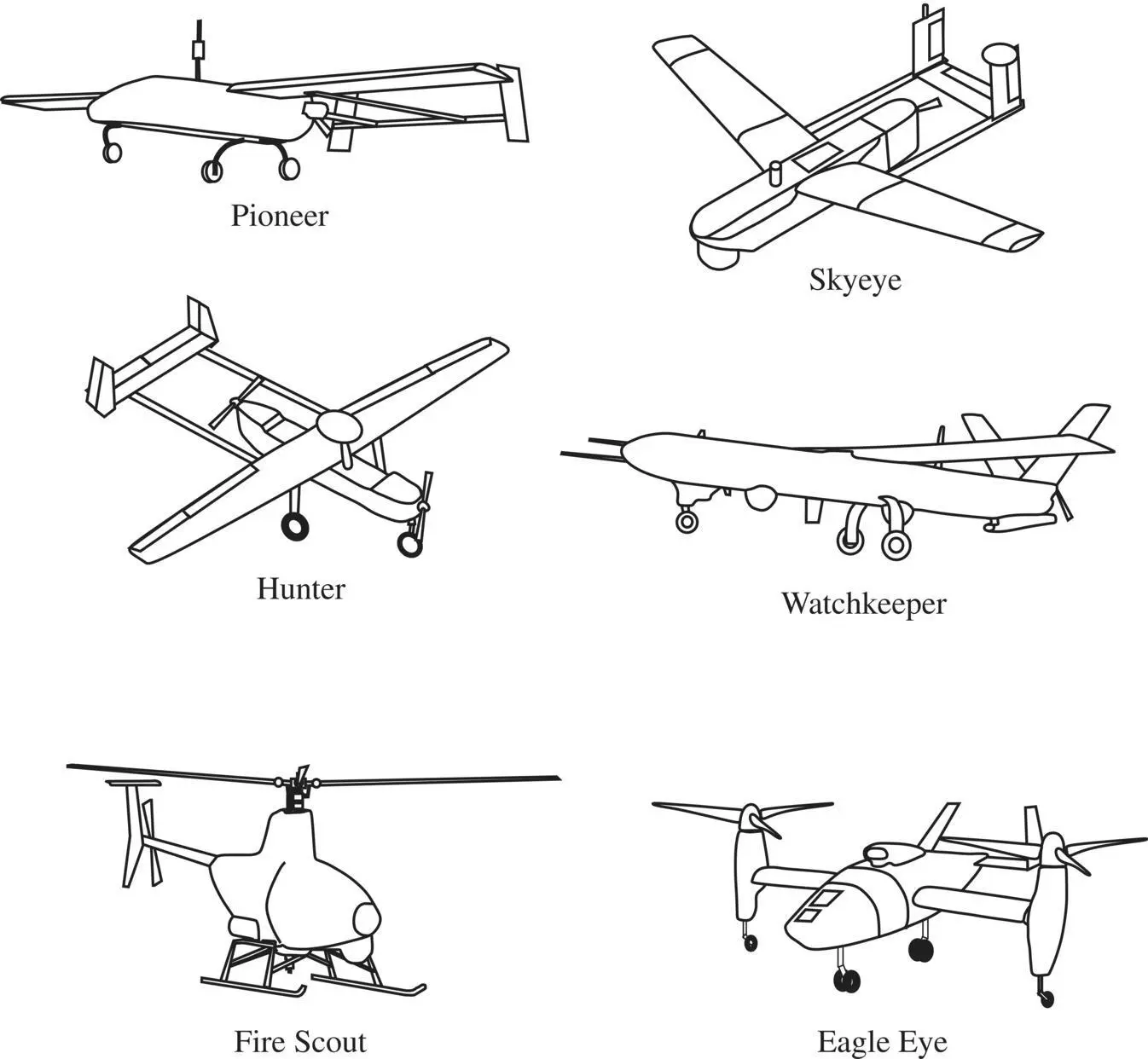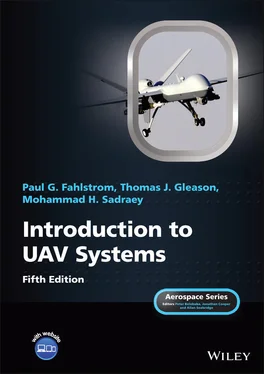Perhaps the most unique feature of the Skyeye when it was fielded was the various ways in which it could be recovered. The Skyeye has no landing gear to provide large radar echoes or obstruct the view of the payload. The avoidance of a nose wheel is particularly significant as a nose gear often obstructs the view of a payload camera looking directly forward, precluding landing based on the view through the eyes of the camera. However, it can land on a semi‐prepared surface by means of a retractable skid located behind the payload. This requires the landing to be controlled by observing the air vehicle externally during its final approach. This is particularly dangerous during night operations.
The landing rollout, or perhaps more accurately the “skid‐out,” is about 100 m (322 ft). The Skyeye also carries either a parafoil or a parachute as an alternative recovery system. The parafoil essentially is a soft wing that is deployed in the recovery area to allow the air vehicle to land much more slowly. The parafoil recovery can be effective for landing on moving platforms such as ships or barges. The parachute can be used as an alternative means of landing or as an emergency device. However, using the parachute leaves one at the mercy of the vagaries of the wind, and it primarily is intended for emergency recoveries. All of these recovery approaches are now offered in various fixed‐wing UAVs, but having all of them as options in one system still would be unusual.
The RQ‐5A Hunter was the first UAS to replace the terminated Aquila system as the standard “Short Range” UAS for the US Army. The Hunter does not require a recovery net or launcher, which significantly simplifies the overall minimum deployable configuration and eliminates the launcher required by the Skyeye. Under the appropriate conditions, it can take off and land on a road or runway. It utilizes an arresting cable system when landing, with a parachute recovery for emergencies. It is not capable of net recovery because it has a tractor (“puller”) propeller that would be damaged or broken or would damage any net that was used to catch it. It also has a rocket‐assisted takeoff option to allow the launch to occur when no suitable road or runway is available.
The Hunter is constructed of lightweight composite materials, which afford ease of repair. It has a 10.2‐m (32.8‐ft) wingspan and is 6.9 m (22.2 ft) long. It is powered by two four‐stroke, two‐cylinder (v‐type), air‐cooled Moroguzzi engines, which utilize fuel injection and individual computer control. The engines are mounted in‐line – tractor and pusher – giving the air vehicle twin engine reliability without the problem of unsymmetrical control when operating with a single engine. The air vehicle weighs approximately 885 kg (1,951 lb) at takeoff (maximum), has an endurance of about 12 h, and a cruise speed of 120 knots.
The Hermes 450/Watchkeeper is an all‐weather, intelligence, surveillance, target acquisition and reconnaissance UAV. Its dimensions are similar to the Hunter. The Watchkeeper is manufactured in the United Kingdom by a joint venture of the French company Thales and the Israeli company Elbit Systems. It has a weight of 450 kg (992 lb) including a payload capacity of 150 kg (331 lb). The Watchkeeper was in service in Afghanistan with British forces late in 2011.
A series of rotary‐wing UAVs called the AT10, AT20, AT100, AT200, AT300, and AT1000 have been developed by the UK firm Advanced UAV Technology. They are all conventionally configured helicopters with a single main rotor and a tail boom with a tail rotor for yaw stability and control. The rotor diameters vary from 1.7 m (5.5 ft) in the AT10 to about 2.3 m (7.4 ft) for the AT1000. Speed and ceiling increase as one moves up the series, as does the payload capacity and payload options. All are intended to be launched by vertical takeoff and all claim the ability for autonomous landings on moving vehicles.
The Northrop Grumman MQ‐8B Fire Scout is an example of a conventionally configured VTOL UAV. It looks much like a typical light helicopter. It has a length of 9.2 m (30 ft) (with the blades folded so that they do not add to the total length), height of 2.9 m (9.5 ft), and a rotor diameter of 8.4 m (27.5 ft). It is powered by a 420 hp turbine engine. The Fire Scout is roughly the same size as an OH‐58 Kiowa light observation helicopter, which has a two‐man crew and two passenger seats.
The Kiowa has a maximum payload of about 630 kg (1,389 lb), compared to the 270 kg (595 lb) maximum payload of the Fire Scout, but if one takes out the weight of the crew and other things associated with the crew, the net payload capability of the Fire Scout is similar to that of the manned helicopter. The Fire Scout is being tested by the US Army and Navy for a variety of missions that are similar to those performed by manned helicopters of a similar size.
The tilt‐rotor Bell Eagle Eye was developed during the 1990s. It uses “tilt‐wing” technology, which means that the propellers are located on the leading edge of the wing and can be pointed up for takeoff and landing and then rotated forward for level flight. This allows a tilt‐wing aircraft to utilize wing‐generated lift for cruising, which is more efficient than rotor‐generated lift, but still to operate like a helicopter for VTOL capability.
The Eagle Eye has a length of 5.2 m (16.7 ft) and weighs about 1,300 kg (2,626 lb). It can cruise at up to about 345 km/h (knots) and at altitudes up to 6,000 m (19,308 ft). Some of these UAVs are shown in Figure 2.5.
The Bayraktar TB2 – as a precision strike MALE UAV – is developed by Baykar Makina, a Turkish company. It has a length of 6.5 m (21 ft), a wingspan of 12 m (39 ft), and a maximum takeoff weight of 1430 lb. The UAV is equipped with a 100 hp piston engine, carries a 330 lb payload (EO/IR/LD imaging and targeting sensor), and features four hardpoints for laser‐guided smart munition (missiles/rockets). The performance includes: (1) maximum speed of 120 knots, (2) range of 150 km, (3) service ceiling of 27,000 feet, and (4) endurance of 27 hours. As of July 2021, the TB2 UAV has completed 300,000 flight‐hours globally.
Our informal size groupings are not finely divided, and we will discuss all UAVs that are larger than a typical light manned aircraft in the group called “large.” This includes, in particular, a group of UAVs that can fly long distances from their bases and loiter for extended periods to perform surveillance functions. They also are large enough to carry weapons in significant quantities. The lower range of such systems includes the US General Atomics Predator A, which has a significant range and endurance, but can carry only two missiles of the weight presently being used.

Figure 2.5 Medium UAVs
The limitation to two missiles is serious as it means that after firing the two missiles that are onboard, the UAV either has lost the ability to deliver weapons or must be flown back to its base to be rearmed. For this reason, a second generation of UAVs designed for missions similar to that of the Predator, including a Predator B model (i.e., Reaper), is now appearing that is larger and able to carry many more weapons on a single sortie.
The Cassidian Harfang is an example of a system much like the Predator A and the Talarion, also by Cassidian, is an example of the emerging successors to the Predator A.
At the high end of this size group, an example is an even larger UAV designed for very long range and endurance and capable of flying anywhere in the world on its own, the US Northrop Grumman Global Hawk (see Figure 1.4).
Читать дальше













